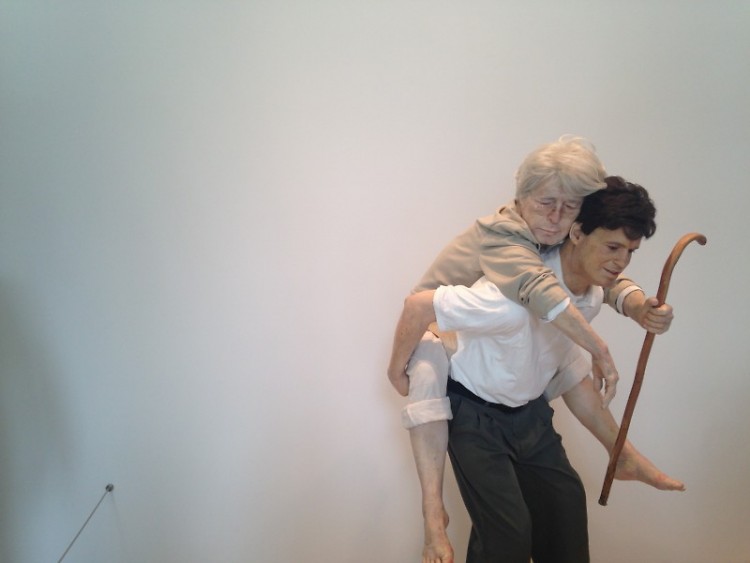I had heard that Marc Sijan was an “interesting character.” I had heard that he was following in Duane Hanson’s footsteps after studying under him. I had even heard that he was pandering to the ArtPrize audience, sizing us up and playing the game, creating something outside his normal body of work to appeal to our voters.
If all of that is true, it seems to be working. Sijan’s piece, “Reciprocity” at the Grand Rapids Art Museum, is in the running as one of the top five selections by public vote in the 3-D category.
It also was and continues to be my nearly-4-year-old son’s favorite work.
“And do you know what I liked?” my son said, falling asleep the night after seeing Sijan’s work. “I liked the man holding his daddy."
My son and I have talked about this work several times since then. It has stuck with us. We keep thinking about it, processing it, recognizing the layers that aren’t always present in representational work. And I’ll be honest- I don’t usually gravitate to hyper-realism. Normally, it bores me. But I was quite the opposite of bored with Sijan’s work.
So I sat down with the artist to find out more about his process, his purpose and his reason for competing in ArtPrize. I wanted to know who was right. Was the public- and a boy who has grown up surrounded by ArtPrize- right? Or were the critics on to something?
There was an incredible story of his father, ever by his side helping him run the “business” of his art so that he could create it. There was the story of his father’s passing and his promise to create something for him. There was the fact that Sijan hadn’t paid much attention to ArtPrize until one of his collectors urged him to sign up this year.
Sijan even says he didn’t really want to let the audience in on the story of who these two people were- he didn’t want to give that narrative of the father and son away to anyone reading the placard next to his work. This was all helping me understand better his process as an artist and how this work was created.
He also admits to being fascinated by facial expressions and features. His character study, as he describes how he observes people and families, goes deeper than most of us notice. His work, then, reminds us about those details, and the hidden stories they tell.
“I would see these match-ups. I’d see personalities. I see these little idiosyncracies, these little mannerisms that they do,” he says. “Things that you can’t even explain of a character and how they’re acting- and I would see that in them.”
This particular story in “Reciprocity,” though, is about his father and their relationship. It’s a tribute, Sijan reluctantly admits, to everything his father gave to him.
“I was a young man, and I was teaching art. I liked the kids and I liked teaching, but I had this yearning,” he says. “Everybody wanted me to stay structured and be a teacher and get a paycheck.”
That’s when his father approached him and offered to be his assistant so that he could become a full-time artist. He rebuffed his offer at first, but then realized he needed the help. Thus began 33 years of working in his studio six feet away from his father’s desk.
“He allowed me to be an artist,” he says. “Because he did all the stuff I hated- the bookkeeping, the accounting, the tax stuff, the correspondence- he was doing all that, [and in doing so] he released me to be an artist.”
And now, he says, now that he has told the story of his father in this piece, his greatest struggle is the search for the next thing he needs to say.
“I try not to go where I’ve already been,” he says. “I can do my most successful pieces over and over again... [but] I already said it- I already did it.”
I was drawn in, much like I was to his work, to the story of Marc Sijan’s work and process. But it wasn’t until Sijan, a man who claims to not be good with words, referenced Aristotle that I believed he wasn’t just spinning a tale.
“The aim of art,” says Aristotle, “is not to represent the outward appearance of things, but their inward significance.”
Sijan is battling, through highly-representational figurative work, to get deeper.
“The hardest part that I have,” he says, “is the story.” Sijan spends more time trying to get deeper into the purpose, message and story of his figures than he does the creation of their physical attributes.
“I don’t want to do something that I’ve already done. I don’t want to do something someone else has done,” he says. “I’m always trying to go a little bit further beyond the physical part of the sculpture, which everybody is fascinated by... There’s really more to it than that... It’s beyond the surface level, it’s beyond the technique- that’s where it really happens.”
The Rapidian, a program of the 501(c)3 nonprofit Community Media Center, relies on the community’s support to help cover the cost of training reporters and publishing content.
We need your help.
If each of our readers and content creators who values this community platform help support its creation and maintenance, The Rapidian can continue to educate and facilitate a conversation around issues for years to come.
Please support The Rapidian and make a contribution today.
